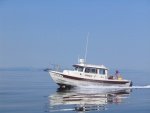thataway
Well-known member
- Joined
- Nov 2, 2003
- Messages
- 21,690
- Reaction score
- 61
- C Dory Year
- 2007
- C Dory Model
- 25 Cruiser
- Hull Identification Number
- DOR25652A707
- Vessel Name
- thataway
RoseDoctor":1ql2oex4 said:Any problem with condensation forming between the cushions and the fiberglass beneath?
Yes
Google "HyperVent". There are also some threads in the forum.
We have used back packing pads, and seem to work about as well. (under as well as up the inside of the hull. So far we have not bothered to cover the side of the hull with canvas or other cloth. Makes it easier to remove if cleaning is necessary.

